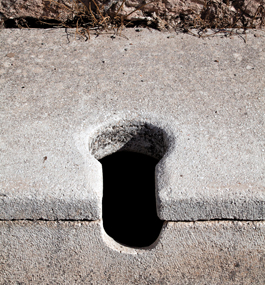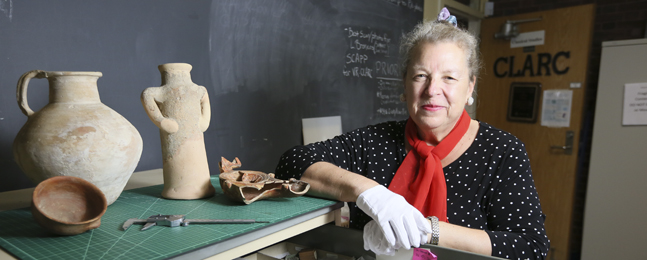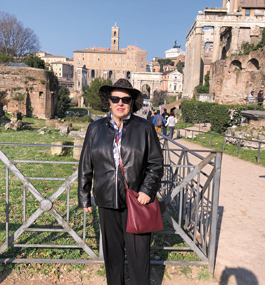Down and Dirty in Ancient Rome
Ann Olga Koloski-Ostrow brings the everyday realities of the classical world — including its toilets and sewer systems — to life.

I. Gercelman / Getty Images
by Sarah C. Baldwin
In many ways, classical archaeologist Ann Olga Koloski-Ostrow has always been an anomaly. Affectionately known by the initials “AOK-O,” she spent nearly 40 years teaching at Brandeis, retiring at the end of June as the Kevy and Hortense Kaiserman Endowed Chair in the Humanities, widely heralded for her scholarship in her field.
But her education began humbly, in a three-room schoolhouse in rural western Massachusetts. She trained as a classical archaeologist at a time when women working on European and Middle Eastern excavation sites were few and far between. And while her classical-studies peers were researching epic poets, emperors and similarly lofty figures, she opted to go quotidian and discover everything she could about ordinary Romans’ day-to-day activities.
Koloski-Ostrow’s scholarship takes particular notice of the ancient world’s public sanitation systems. This is an interest at least partly due to what she calls her “19th-century childhood in the 20th century.”
Her parents raised her and her three siblings in Sandisfield — then a town of 400, located on the Connecticut border — in a house with no indoor plumbing. The family used chamber pots at night and a three-seater outhouse during the day. Until her father’s death in 1961 at age 47, Koloski-Ostrow would watch as, once a year, he emptied the cesspit beneath the outhouse.
And then there were her uncles. Koloski-Ostrow recalls visiting her Uncle Ted, a plumber in Boston, where she would “climb under these grand houses, and look at the copper piping, and see him fixing these unbelievably elegant toilets.” On visits to her Uncle Nick, a garbage collector in New York City, she’d ride beside him during his night rounds, learning about the well-to-do from what they threw away, and about the poor from what they repurposed.
Meanwhile, two beloved teachers at Searles High School, in Great Barrington, about 20 miles northwest of Sandisfield, introduced her to the classics discipline and pushed her to excel in her studies.
In 1967, Koloski-Ostrow’s unusual background and her classical interests converged when, encouraged by her high school mentors, she applied and was admitted to Upsala College, in New Jersey. (She was the second resident of Sandisfield to attend college in the 20th century; her older brother Stanley was the first.)
The journey that would lead Koloski-Ostrow to her eventual ordination as classical studies’ “Queen of Latrines” was underway.
Material girl
During the summer after her first year at Upsala, Koloski-Ostrow went to Italy on a scholarship, to be trained in archaeological methods at Herculaneum, an ancient Roman town destroyed when Mount Vesuvius erupted in 79 C.E.
Herculaneum is better preserved than Pompeii and similar sites because it was covered in volcanic mud, which instantly sealed everything — people, houses and objects — in place. Koloski-Ostrow found her curiosity was piqued by questions about the city’s material culture and, in particular, the objects of everyday life. What were the Romans’ homes like? What did they eat? What did they wear? What illnesses did they have? Where and how did they relieve themselves?
“I was fascinated by the fact that I could develop a whole research strategy about daily life — not of the wealthy or the poorest of the poor, but of the general population,” she says. “When I started thinking about what research has never been done on the ancient world, I realized I had some personal experiences that might help me understand the things I was curious about.”
In 1971, armed with solid excavation skills and a BA cum laude in ancient Greek and Latin, Koloski-Ostrow climbed into her old Ford Econoline — a graduation present from Stanley — and drove west to Ann Arbor to begin graduate studies at the University of Michigan, where she would earn a master’s in Latin and Greek language and literature, followed by a PhD in classical art and archaeology.
During her first year there, at one of the weekly teas for graduate students, she was introduced to a fellow scholar who had just returned from a dig in Libya. She remembers thinking, “This is a guy I’d like to know better.” The young man was Steven E. Ostrow, who went on to teach Greek, Roman and medieval history, and Latin literature at MIT. They were later married near Massell Pond on the Brandeis campus.
Koloski-Ostrow’s knowledge of Greek and Latin made her an unusual archaeologist. Traditionally, philologists (scholars of the history of language and literary texts) and classical archaeologists have regarded each other with some skepticism. Koloski-Ostrow, on the other hand, believed the two approaches to understanding the ancient world are mutually enriching.
“I hated this notion that philologists look down their noses at archaeologists as the dirt diggers,” she says, “and archaeologists look down their noses at philologists as people who know how to conjugate verbs and decline nouns but have never seen the ruins. I kept saying to both sides, ‘If you would work together, you could bring the ancient world alive.’”

Mike Lovett
HANDS-ON: Koloski-Ostrow with items from the Classical Studies Artifact Research Collection.
page 2 of 3
‘Open and fun’
When Koloski-Ostrow applied for a job at Brandeis in 1985, her conviction that archaeology and philology belonged in the same classroom was one of the many qualities she had that Leonard Muellner, now professor emeritus of classical studies, found appealing.
“Ann brought the whole package,” Muellner says. Not only was she publishing important research, and could teach Greek and Latin as well as archaeology, she had “personal skills that were way beyond what you expect in a classics person.”
It was an invaluable mix. “In a small department like ours, finding someone as open and fun as Ann, someone who could reach out and connect to students — that’s what classics departments need,” says Muellner. “If you’re a wonderful teacher, you get students interested in your subject, and they go on to populate other courses in the department.”
Koloski-Ostrow was hired as a visiting lecturer with a one-year contract, the department’s first classical archaeologist. By 2000, she had tenure. In 2003, she was named chair of the department, a position she held for 15 consecutive years. In 2007, she was named the Kaiserman Chair. In 2013, she became a full professor. From 2019-21, she served as head of the university’s Division of Humanities.
In addition to handling her teaching and administrative duties, she was publishing journal articles, books, book chapters and reviews on topics that reveal a remarkably wide range of interests and expertise, from toilets (see the sidebar) to diseases, from hydraulics to the archaeology of smell.
The seriousness of her scholarship is often leavened by humor and an unblinking embrace of the real, as evidenced by such titles as “Roman Toilets: The Black Holes of Ancient Space” and “Roman Latrines: How the Romans Did Their Business.”
 |
|
Sidebar Story |
 |
“I’m a specialist in Greek poetry,” says Muellner. “Take Homer, or anyone else: Nobody ever goes to the bathroom; it’s just not a heroic thing. Ann’s work makes ancient life much more approachable.”
Long before digital humanities projects like Peopling the Past — which focuses on “real people” in the ancient world — Koloski-Ostrow set about understanding more-marginalized non-elites: women, prostitutes, slaves. The classes she’s taught have included Women, Gender and Sexuality in Greek and Roman Art and Text, and Roman Sex, Violence and Decadence in Translation, alongside more time-honored topics, like Classical Myths Told and Retold, and Pompeii: Life in the Shadow of Vesuvius.
Keeping the past in the present
During Koloski-Ostrow’s four decades at Brandeis, the vocational utility of the humanities has increasingly been called into question, making departments like hers more vulnerable to administrative belt-tightening. Despite this, Muellner says, her blend of collegiality and scholarship helped the Department of Classical Studies thrive.
“Knowing how to interact with people from other disciplines is key,” he says. “Teaching about women, sexuality, health, sanitation — this takes cultures off a pedestal on which they do not belong. The contributions of people like Ann are hugely important for the survival of the classics.”
Koloski-Ostrow — who also held an affiliation with a number of other academic departments and programs at Brandeis: anthropology; fine arts; Italian studies; Medieval and Renaissance studies; and women’s, gender and sexuality studies — says she’s pleased the classical studies department attracts minors from across the campus, including from outside the humanities. A budding chemist, she points out, can use science to show that what was originally thought to be a soup bowl is actually a chamber pot.
One place for doing that is Brandeis’ Classical Studies Artifact Research Collection, which Koloski-Ostrow founded in 2006. The CLARC, made up of nearly 1,000 ancient Mediterranean artifacts, including figurines, ceramics, weapons, coins and perfume bottles, offers undergraduate and graduate students hands-on experience with ancient objects, which can lead to fieldwork and other research opportunities.
Koloski-Ostrow also had the idea of helping her embattled department generate revenue by establishing a master’s program. The move enabled classical studies to “consolidate itself,” says Muellner, and produces an ever-growing number of students who pursue doctorates at some of the best classical and archaeological programs in the U.S., including at Ohio University, Stanford, Harvard and Michigan.
Establishing a graduate program, Koloski-Ostrow says, “happened because I have colleagues who believed in the worth of our field and wanted to show the administration how hard we’re willing to work to keep classical studies there, because we believe it makes people better humans.”

Courtesy Ann Olga Koloski-Ostrow
RETRACING TIME: Koloski-Ostrow in the Roman Forum in 2019.
page 3 of 3
Head of the class
Koloski-Ostrow’s enthusiasm for her subject is evident in her prolific scholarly work; her many media interviews and invited talks; and her visiting professorships, including at the American Academy in Rome and the Vergilian Society of America.
And it was always on full, three-dimensional display in the classroom. Stephen Guerriero, GSAS MA’15, a sixth-grade teacher in the Needham, Massachusetts, public school system, first encountered Koloski-Ostrow in 2010 when he enrolled in The Examined Life, a professional development course for teachers, formerly based at Brandeis. Koloski-Ostrow was the principal faculty member.
The course, which included a two-week trip to Greece led by Koloski-Ostrow and her husband, inspired Guerriero to enroll in the Brandeis classical-studies master’s program in 2012. Koloski-Ostrow’s course on classical myths “totally opened me up,” he says, adding that her teaching on gender and sexuality taught him to look at the classical world through a new lens.
Guerriero recalls a day in class when Koloski-Ostrow was reading from “The Iliad”: “Priam comes to ransom the body of [his son] Hector. Priam is crying, and Achilles is crying and thinking of his own father. And Ann is fully, openly weeping. These people are real for her.”
“I feel very strongly that my job as a teacher is not to fill empty spaces in my students’ brains with my knowledge, but to excite students to become a part of the learning experience,” Koloski-Ostrow says. “They have to believe they can teach me as much as I can teach them. And if they believe that, they will take the experience of working with me much more seriously and enthusiastically than if they’re just sitting there, furiously taking notes. They trust me, and I trust them, and we count on each other to make the best class we can.”
Perhaps it’s no surprise that Koloski-Ostrow has received nearly every teaching award Brandeis offers. She’s also earned such national honors as the Archaeological Institute of America’s Excellence in Undergraduate Teaching Award, and the National Award for Excellence in the Teaching of Classics from the American Philological Association (now the Society for Classical Studies). She is, by all accounts, the only classicist in the U.S. to have won both awards.
Former student Joel Christensen ’01, GSAS MA’01, who returned to the classical studies department as a faculty member in 2016 and chaired the department from 2018-22, has also received the Society for Classical Studies teaching award. “Ann was everything a first-year student from rural Maine needed: energetic, engaging, irreverent and deeply kind,” he says. “Returning to Brandeis as a faculty member and her colleague was one of the greatest honors of my life.”
Despite Koloski-Ostrow’s retirement, her work of making us privy to the realities of Roman life is far from over. The AIA has invited her to be its Charles Eliot Norton Memorial Lecturer for 2022-23, giving lectures across North America — one of the highest honors the organization bestows.
She has three books under contract: “The Bloomsbury Cultural History of Technology, Vol. I: Pre-History Through Antiquity” (Bloomsbury Publishing), which she is co-editing; “66 Toilets and Urinals in the Ancient City of Rome: Sanitary, Urbanistic and Social Agency” (Brill), which she is also co-editing; and “Making Sense of Pompeii and Herculaneum: Smells, Tastes, Sensations and Physical Realities — the Little Things That Made Roman Daily Life Worth Living” (Cambridge University Press), which she is writing.
She’s recently been appointed to serve as a board member at the Archaeological Institute of America, the American Academy in Rome and the American School of Classical Studies at Athens.
And, although she reports she has no plans to “get in the dirt” — apart from her garden — she will be closely following developments in the field and doing her best to keep students everywhere interested in what’s happening.
“The excitement for me,” she says, “is that a new excavation might turn up something that clarifies a whole area of the ancient world we thought we understood, but didn’t.”
Sarah C. Baldwin is a freelance writer living in Providence, Rhode Island.
